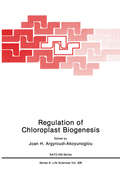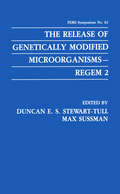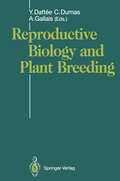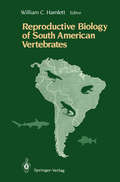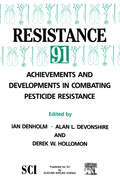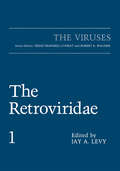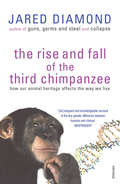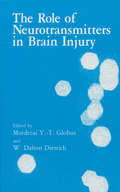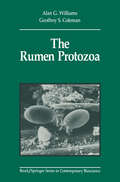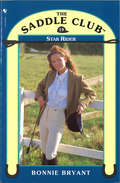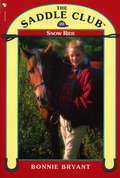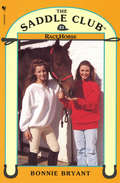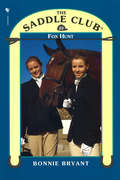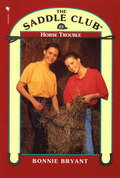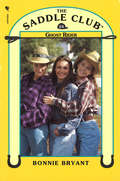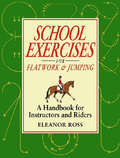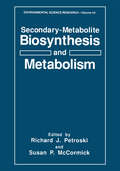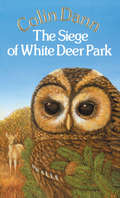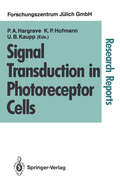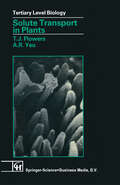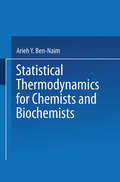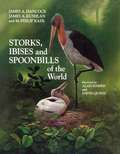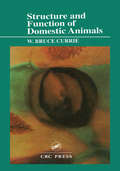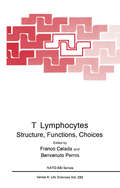- Table View
- List View
Regulation of Choloroplast Biogenesis (Nato Science Series A: #226)
by Joan H. Argyroudi-AkoyunoglouFrom July 28 to August 3, 1991, an International Meeting on the REGULATION OF CHLOROPLAST BIOGENESIS was held at the capsis Beach Hotel in Aghia Pelaghia, on the island of crete, Greece. The Meeting (Advanced Research Workshop-Lecture Course) was co-sponsored by NATO, FEBS and IUB, and was held under the auspices of the International society for Chloro plast Development, the Greek Ministry of Industry, Research and Technol ogy, and the National Center for Scientific Research "Demokritos". The Meeting focused on recent advances in the field of chloroplast biogenesis and the regulatory mechanisms underlined, and brought together over 120 experts and students of the field from 22 countries. The subject of chloroplast biogenesis has experienced great progress in recent years mainly thanks to the application of Molecular Biology techniques and methodology. New findings that emerge gradually unravel the regulatory mechanisms involved in the assembly, stabilization and growth of the photosynthetic units in thylakoids, the signal transduction chain leading from photoreception to gene expression, the transport of nuclear-coded proteins into stroma-soluble supramolecular enzyme complexes as well as thylakoid-bound supramolecular complexes, involved in light-energy transduction. It was the aim of this meeting to bring together experts and students coming from diverse disciplines (ranging from Botany and plant physiology to Molecular Biology, Biophysics and Biotechnology), to discuss the recent advances in the field so that thorough exchange of ideas and working hypotheses would be achieved.
The Release of Genetically Modified Microorganisms—REGEM 2 (F.E.M.S. Symposium Series #63)
by Duncan E. S. Stewart-Tull Max SussmanIf ripple effect is a measure of greatness in scientific discovery then GEMMOs have a lot going for them and this book dramatically illustrates the risks associated with advances being made by researchers to mobilize and control the power of the microorganism in the world's fight to perfect nature and fmd remedies for its imperfections. In the field of genetic science it is abundantly clear that so much more can be achieved through prevention rather than cure and that the indirect kill, by reason of its logic is a much more powerful weapon for winning results. Nevertheless the dilemma facing politicians arises over whether man should tamper with something which is God-given such as Radioactivity and Genetic endowment. The Roman Catholic church fmds difficulty in accepting the proposition that what is God given can be treated as a product under human control and maybe that is why recently half a century of genetic research on a strain of bees resistant to a devastating parasite at the Buckfastleigh Benedictine Monastery has inexplicably ceased whilst verging on scientific success.(l) The Anglican Community on the other hand does not see the sacrosanctity of Radioactivity and Genetic material as a bar to man-manipulation with appropriate safeguards.
Reproductive Biology and Plant Breeding: Biologie de la Reproduction et Amélioration des Plantes
by Yvette Dattee Christian Dumas Andre GallaisThis volume has been produced for the XI 11th EUCARPIA Congress. EUCARPIA (the European Association for Plant breeding) currently has 1.200 members, including scientists and staff of both publ ic and private organizations. Its aim is to promote scientific and technical research and cooperation In the field of plant breeding, and thereby to contribute to the development of agriculture. Every three years, EUCARPIA organizes a scientific congress. In 1992, the Xilith EUCARPIA Congress will be held In ANGERS (Fran ce) and the theme Is "Reproductive biology and plant breeding". Reproduction of plant material Is central to selection. The geneti cist, the plant breeder and the seed grower all use sexual and ve getative reproduction during the various stages of plant breeding and creation of variety. The possibility of unlimited interspecific reproduction, the use of gametogenesis dysfunction, the creation of auto and allogamy, and the cloning of the best genotypes are the challenges before the plant breeder. To understand how the reproductive system conditions the genetic structure of a population, and to Investigate the relation ships between the reproductive mode and the organization of varia bility Is a central key to genetic progress. The articles presented In this book review the current state of knowledge of reproductive biology, and Its impact on variety crea tion.
Reproductive Biology of South American Vertebrates
by William C. HamlettSouth America is one of the few areas of the world that includes vast areas of as yet undisturbed natural habitats. These areas are home to as many as half the world's species of plants and animals. Many of the animals inhabit ing these areas are of direct and immediate economic importance, while others are of unknown potential value. With economic development of these areas, there is a coincident disruption of natural habitats that have a direct impact on the reproductive capabilities of the affected species. Re production is central to the survival of all species and, regardless of the environmental stresses imposed on them, scientific attention must be fo cused on reproductive biology as a way to deal with these pressures. It is vitally important to gather as much research data as possible on the repro ductive biology of the species on this continent in order to provide gov ernmental agencies and scientists with the most accurate information on which to base decisions regarding development. This volume is intended to draw attention to these pressing matters by gathering a wide representation of scientists actively engaged in reproduction research relating to South American vertebrates. It is intended that this volume will serve as a re source for individuals and organizations interested in reproductive biology and species survival. An additional benefit is that economically important species, as well as potentially important ones such as sharks, will be dis cussed.
Resistance’ 91: Achievements and Developments in Combating Pesticide Resistance
by I. Denholm A. Devonshire D. HollomonThe development of pesticide resistance in arthropod pests, plant pathogens and weeds can be viewed and studied from two contrasting perspectives. At a fundamental level, resistance provides an almost ideal example of adaptation to withstand severe environmental stress. Population geneticists, biochemists and, most recently, molecular biologists have cast considerable light on the nature of this adaptation in diverse taxonomic groups, and on factors determining its selection and spread within and between populations. Unlike most evolutionary phenomena, however, resistance is also of immediate practical and economic significance. Not only has the number of resistant species continued to increase inexorably, but there has been an alarming increase in the severity and extent of some resistance problems. Cases of organisms resisting virtually all available pesticides are by no means uncommon, and pose a formidable challenge in view of present difficulties in discovering and developing novel chemicals. Although most occurrences of resistance were initially monofactorial, resistance now frequently involves a suite of coexisting mechanisms that protect organisms against the same or different pesticide groups, and may even predispose them to resist new, as yet unused chemicals.
The Retroviridae (The Viruses)
by Jay A. LevyProviding both historical background and recent advances, this series reviews in-depth the biologic, molecular, immunologic, and patholic features of this facinating virus family. The current volume focuses on the avian and murine species which have generated novel insights into cancer, and the evolution of the retroviridae.
The Rise And Fall Of The Third Chimpanzee: How Our Animal Heritage Affects The Way We Live
by Jared DiamondMore than 98 percent of human genes are shared with two species of chimpanzee. The 'third' chimpanzee is man. Jared Diamond surveys out life-cycle, culture, sexuality and destructive urges both towards ourselves and the planet to explore the ways in which we are uniquely human yet still influenced by our animal origins.
The Role of Neurotransmitters in Brain Injury
by W. D. Dietrich M. Y. T. GlobusNeuroscientists from various disciplines have given extraordinary attention to the role of neurotransmitters in the field of neuronal injury. This volume summarizes the original oral and poster contributions which were presented at the symposium, "The Role of Neurotransmitters in Brain Injury," in Key West, Florida, between June 7-9, 1991. This symposium was the official Satellite of Brain-91, the Fifteenth International Symposium on Cerebral Blood Flow and Metabolism, held in Miami the previous week. The two principal goals of the Key West satellite meeting were to document recent progress and, more importantly, to explore future directions for investigative studies of the role of neurotransmitters in brain injury. To achieve these goals we assembled participants from diverse scientific fields and specialties who brought their collective expertise to discussions on the importance of neurotransmitters in neuronal and vascular injury following brain ischemia, trauma, and epilepsy. Their contributions are reflected in this volume. An important section of this volume is devoted to the role of glutamate and glutamatergic receptors in the development of ischemic neuronal damage. Topics covered include the mechanisms of glutamate and other excitatory amino acids, and the role of underlying injury-induced release different glutamatergic receptors in brain injury, including the NMDA and the non-NMDA receptors. The involvement of other neurotransmitters in the process of ischemic brain injury is well established.
The Rumen Protozoa (Brock Springer Series in Contemporary Bioscience)
by Alan G. Williams Geoffrey S. ColemanAll ruminants are dependent on the microorganisms that live in their forestomach - the rumen - to break down ingested feed constituents into a form that the host animal can utilize. Protozoa are part of this complex ruminal population and are essential for the nutritional well-being and productivity of the host ruminant. Over 30 different genera (nearly 300 species) of protozoa from the rumen ecosystem have been described since their initial discovery nearly 150 years ago. This book brings together, for the first time, the available information on these protozoa. It comprehensively describes the characteristic anatomical features of value for their identification and includes detailed sections on techniques and methodologies for the isolation and cultivation of these fastidious, oxygen-sensitive microorganisms. Their occurrence, biochemistry, physiology, and role in the ruminal ecosystem are fully reviewed. Particular emphasis is given to potential improvement of the nutrition and productivity of the host ruminant through manipulation of the protozoal population and its activities.
Saddle Club Book 19: Saddle Club Bindup 10 (The\saddle Club Bindup Ser. #No. 10)
by Bonnie BryantLisa, Carole and Stevie can’t believe their luck: Skye Ransom, the teen idol the Saddle Club met on their trip to New York City, is about to star on a new movie – and he wants the girls to help him with his riding! It’s a dream come true, especially when the director casts Lisa in a small part. But then Lisa discovers how lonely the life of a star can be, and Carole and Stevie realize how much they need their best friend’s help with plans for Carole’s father’s birthday. Will the Saddle Club manage to arrange a big birthday celebration and help Skye overcome his fear of horses?
Saddle Club Book 20: Saddle Club Bindup 10 (The\saddle Club Bindup Ser. #No. 10)
by Bonnie BryantSaddle up for some more great riding with the girls of Pine Hollow!Stevie's friend Dinah has invited her to go sugaring in Vermont! She is ready for riding and is determined to help Dinah win the sugar off competition. The winning team gets the first pick of horses for the summer. All is well until Dinah gets hurt, and she makes Stevie promise not to tell...
Saddle Club Book 21: Race Horse (The\saddle Club Bindup Ser. #No. 35)
by Bonnie BryantWhen Carole discovers that her horse Starlight has a slight injury, she’s disappointed at having to spend the next two weeks without a mount. But Judy, a local veterinarian, has an idea: Carole can spend her time with dozens of horses, helping Judy out after school and at the weekends. Carole jumps at the chance, especially since among Judy’s ‘patients’ are some magnificent racehorses. What could be more exciting than working with a stable full of beautiful thoroughbreds?But Carole soon learns that caring for racehorses isn’t all fun. During a race, a horse named Prancer is badly injured, and she’ll never compete again. When Prancer’s owner immediately decides to sell her, Carole is horrified. Can she and the rest of The Saddle Clun find a new home for the beautiful racehorse?
Saddle Club Book 22: Saddle Club Bindup 11 (The\saddle Club Bindup Ser. #Vol. 11)
by Bonnie BryantThe Saddle Club girls are in for some real excitement when Stevie’s boyfriend Phil invites them – along with a few other kids from their Pony Club – to participate in a genuine fox hunt. Stevie, Lisa and Carole can’t wait for the event to begin, especially when they find out that no harm will come to the fox. But first, to give everyone a chance to learn the ropes, there’s a mock hunt in Pine Hollow Stables. As the most devious of the bunch, Stevie is chosen to play the fox. On the day of the hunt, she finds she isn’t the only one who’s devious… when her prank-playing brothers get involved in the chase!
Saddle Club Book 23: Saddle Club Bindup 12 (The\saddle Club Bindup Ser. #Vol. 12)
by Bonnie BryantWhen Mrs. Reg, the manager of Pine Hollow Stables, goes away for a few days, The Saddle Club is determined to pitch in and keep things running smoothly. Lisa, Carole and Stevie decide they know everything there is to know about horses, so they’ll have no problem managing a stable for a few days… right? Wrong! Instead it seems that every time the girls try to help, disaster quickly follows. More paint winds up on one of the horses than on the stable; several riders don’t get quite the ride that they expect; and Mrs. Reg’s paperwork is in utter chaos. Soon the members of The Saddle Club are wondering if being horse crazy is enough to manage a stable, after all!
Saddle Club Book 24: Ghost Rider
by Bonnie BryantWhen Lisa, Carole and Stevie head west to the Bar None Ranch, they have a great time planning a Halloween party with their friends Kate and John, a Native American boy who works on the ranch. The Saddle Club is also thrilled when they get the chance to see a herd of wild horses, including the beautiful grey stallion that Kate wants to adopt. Then John tells the girls a mysterious Indian legend about a grey stallion, and warns Kate to keep her distance from the one in the herd. Is John just playing a Halloween trick or is Kate about to ride into danger? The Saddle Club is about to find out!
SCHOOL EXERCISES FOR FLATWORK AND JUMPING: A Handbook For Instructors And Riders
by ELEANOR ROSSThis volume offers ideas and specimen exercises for trainee instructors and more experienced instructors, and for riders schooling their own horses or ponies, and aims to provide purpose, variety and interest to lessons and riding sessions, for teachers, horses and riders.
Secondary-Metabolite Biosynthesis and Metabolism (Environmental Science Research #44)
by Richard J. Petroski Susan P. McCormickThis book was developed from the proceedings of the American Chemical Society, Division of Agricultural & Food Chemistry, subdivision of Natural Products Symposium "Biosynthesis and Metabolism of Secondary Natural Products" held in Atlanta, Georgia, April 1991. The objective of the conference was to bring together people from apparently diverse fields, ranging from biotechnology, metabolism, mechanistic organic chemistry, enzymology, fermentation, and biosynthesis, but who share a common interest in either the biosynthesis or the metabolism of natural products. It is our intention to help bridge the gap between the fields of mechanistic bio-organic chemistry and biotechnology. Our thanks go to Dr. Henry Yokoyama, co-organizer of the symposium, the authors who so kindly contributed chapters, the conference participants, and to those who assisted in the peer review process. We also thank the financial supporters of the symposium: ACS/AGFD, NIH General Medical Sciences, and the agricultural, pharmaceutical, biotechnology, and chromatography companies. A full list of the supporting corporations and institutions is given on the following page. Pharma-Tech and P.C., Inc. are manufacturers of instrumentation for high-speed countercurrent chromatography. We thank the Agricultural Research Service and the U. S. Department of Agriculture for granting me permission to co-organize the conference and for us to complete the book. Richard J. Petroski Susan P. McCormick USDA, ARS, National Center for Agricultural Utilization Research Peoria, IL 61604 June 10, 1992 vii CONTENTS ANTIBIOTICS Polyketide Synthetases: Enzyme Complexes and Multifunctional Proteins Directing the Biosynthesis of Bacterial Metabolites from Fatty Acids. . . . . . . . . . . . . . . . . . . . . . . . . . . . . . . 3 . . . . . . . . . . .
The Siege Of White Deer Park (The\farthing Wood Ser. #Vol. 5)
by Colin DannTerror has come to White Deer Park, driving panic-stricken animals before it. A killer beast is on the loose - a predator so silent and skillful that it leaves almost no trace, and has never been seen.As the deaths mount up, Owl, Fox, Badger and the elders of Farthing Wood meet to make a plan. They have fought tough corners before; have they now, finally, met their match?
Signal Transduction in Photoreceptor Cells: Proceedings of an International Workshop Held at the Research Centre Jülich, Jülich, Fed. Rep. of Germany, 8–11 August 1990 (Research Reports in Physics)
by Paul A. Hargrave Klaus P. Hofmann U. Benjamin KauppThis book deals with the mechanism of signal transduction in vertebrate and invertebrate photoreceptors. It contains contributions on the structure and function of rhodopsin or other G-coupled receptors, on the regulation of second messengers by enzyme cascade, the role of Ca2+ in light adaptation, control of ionic channels in photoreceptor cells.
Solute Transport in Plants (Tertiary Level Biology Ser.)
by T.J. Flowers A.R. YeoThe study of solute transport in plants dates back to the beginnings of experimental plant physiology, but has its origins in the much earlier interests of humankind in agriculture. Given this lineage, it is not surprising that there have been many books on the transport of solutes in plants; texts on the closely related subject of mineral nutrition also commonly address the topic of ion transport. Why another book? Well, physiologists continue to make new discoveries. Particularly pertinent is the characterisation of enzymes that are able to transport protons across membranes during the hydrolysis of energy-rich bonds. These enzymes, which include the H + -A TPases, are now known to be crucial for solute transport in plants and we have given them due emphasis. From an academic point of view, the transport systems in plants are now appreciated as worthy of study in their own right-not just as an extension of those systems already much more widely investigated in animals. From a wider perspective, understanding solute transport in plants is fundamental to understanding plants and the extent to which they can be manipulated for agricultural purposes. As physiologists interested in the mechanisms of transport, we first set out in this book to examine the solutes in plants and where are they located. Our next consideration was to provide the tools by which solute movement can be understood: a vital part of this was to describe membranes and those enzymes catalysing transport.
Statistical Thermodynamics for Chemists and Biochemists
by Arieh Y. Ben-NaimThis book was planned and written with one central goal in mind: to demonstrate that statistical thermodynamics can be used successfully by a broad group of scientists, ranging from chemists through biochemists to biologists, who are not and do not intend to become specialists in statistical thermodynamics. The book is addressed mainly to gradu ate students and research scientists interested in designing experiments the results of which may be interpreted at the molecular level, or in interpreting such experimental results. It is not addressed to those who intend to practice statistical thermodynamics per se. With this goal in mind, I have expended a great deal of effort to make the book clear, readable, and, I hope, enjoyable. This does not necessarily mean that the book as a whole is easy to read. The first four chapters are very detailed. The last four become progressively more difficult to read, for several reasons. First, presuming that the reader has already acquired familiarity with the methods and arguments presented in the first part, I felt that similar arguments could be skipped later on, leaving the details to be filled in by the reader. Second, the systems themselves become progressively more com plicated as we proceed toward the last chapter.
Storks, Ibises and Spoonbills of the World (Helm Identification Guides)
by James Hancock James A. Kushlan M. Philip Kahl Alan Harris David QuinnEverything you ever wanted to know about storks, ibises and spoonbills.
Structure and Function of Domestic Animals
by W. Bruce CurrieStructure and Function of Domestic Animals provides a solid introduction to the functional anatomy of domestic animals. The author covers general principles, phenomena, and mechanisms and then supports this information by providing concrete examples, giving you a working understanding of the biology of animals. Line drawings, tables, and text boxes provide supplemental information. The author examines the functions of animals from the basic to the complex. The pragmatic application of these principles allows for the raising and caring for animals with the appropriate regard for their welfare. He covers morphology, myology, electrophysiology, endocrinology, comparative anatomy, metabolism, cell growth and development, and reproductive mechanisms. The mechanism and phenomena described in this book will introduce you to the flexibility or plasticity of normal animal function. The author's pedagogical writing style clearly delineates normal function and abnormal function. Structure and Function of Domestic Animals explores many of the seemingly endless examples of the ways in which animals apply the fundamental principles of chemistry and physics to preserve their integrity. It gives you an insightful overview to a very broad subject.
Structure and Function of Domestic Animals
by W. Bruce CurrieStructure and Function of Domestic Animals provides a solid introduction to the functional anatomy of domestic animals. The author covers general principles, phenomena, and mechanisms and then supports this information by providing concrete examples, giving you a working understanding of the biology of animals. Line drawings, tables, and text boxes provide supplemental information. The author examines the functions of animals from the basic to the complex. The pragmatic application of these principles allows for the raising and caring for animals with the appropriate regard for their welfare. He covers morphology, myology, electrophysiology, endocrinology, comparative anatomy, metabolism, cell growth and development, and reproductive mechanisms. The mechanism and phenomena described in this book will introduce you to the flexibility or plasticity of normal animal function. The author's pedagogical writing style clearly delineates normal function and abnormal function. Structure and Function of Domestic Animals explores many of the seemingly endless examples of the ways in which animals apply the fundamental principles of chemistry and physics to preserve their integrity. It gives you an insightful overview to a very broad subject.
T Lymphocytes: Structure, Functions, Choices (Nato Science Series A: #233)
by Franco Celada Benventuto PernisThis volume contains the proceedings of the NATO Advanced Study Institute held in Porto Conte (Alghero), Sardinia, September 15-27, 1991. The A. S. 1. was attended by 86 graduate and postgraduate students from 18 different countries, and was hosted by the newly founded International Laboratory of Molecular Genetics of Porto Conte, directed by Prof. Marcello Siniscalco. The A. S. I. was funded by NATO Scientific Affairs Division, the International Union of Immunological Societies, the European Community (Directorate General for Science, Research and Development), the Italian Research Council, and the San Raffaele Institute of Milano. In addition, a number of students who reside in the U. S. received travel funds from the U. S. National Science Foundation, and the Turkish National Fund provided financial assistance to several students from Turkey. When we decided to organize a course on T lymphocytes, our concern was to reach a balance between the teaching of both the hard core principles and the latest experimental findings of cellular immunology, and the recently expanded interfaces with the not-yet known: hypotheses, speCUlations, new projections to be born from the discussions.
